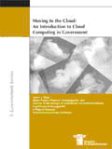 In the corporate world, and throughout the federal government, information is a very valuable asset. Having timely access to this information, and using it to inform strategic decision making, have become critical in today’s competitive, networked, and interconnected world. Information technology (IT) plays a central role in making this happen. We spoke with Dr. Robert D. Childs, senior director, Information Resources Management (IRM) College, about the mission of the IRM College, its successes, its cultivation of the next generation of IT leaders, and its expanding partnerships.
In the corporate world, and throughout the federal government, information is a very valuable asset. Having timely access to this information, and using it to inform strategic decision making, have become critical in today’s competitive, networked, and interconnected world. Information technology (IT) plays a central role in making this happen. We spoke with Dr. Robert D. Childs, senior director, Information Resources Management (IRM) College, about the mission of the IRM College, its successes, its cultivation of the next generation of IT leaders, and its expanding partnerships.
On the Mission and Evolution of the IRM College — We’ve completed celebrating our 20th anniversary last September [2008]. It made us think about a lot of things that have gone on in the past and how it has very much paralleled [changes] in society. We started thinking about what we really do, and we came up with the line, “Shaping the Future.” We put that in our catalog, and then we talked more about what does “Shaping the Future” mean? What do we really do with our classes and our programs? We discovered that what we’re really doing is crossing boundaries—interagency boundaries, international boundaries, and boundaries with the private sector. Building communities of like-minded people was the second thing that we do—and by [extension] we transform organizations. We’re organized to really be flexible, innovative, creative, and be a hothouse for ideas that address the concerns of leaders in the information age. From the very beginning, we set out to do four things. The first was: be a distinctive institution—be unique. We visited [and] benchmarked against other colleges, other universities, and other institutes such as the London School of Economics. I went to Singapore, different institutions in Europe, and tried to learn how we could take their practices and use them. What I found out is, we were very unique already. Point two is: focus on the customer, either individuals or organizations. The third point is to secure and sustain the allegiance of DoD (Department of Defense) and the federal community. If you don’t have allegiance, if you don’t have money coming in, you can’t sustain your programs. Since then, we’ve added the private sector and international partners. The last one: achieve national and international recognition. Some people say, “Well, why are you concerned about that?” Well, it’s the fastest way to get attention and to let other people know what you have and what you can contribute.
On Technologies Shaping the Classroom and Workplace of the Future — I think the classroom of the future and the workplace of the future are almost one and the same thing. We have to tie it to the lifestyle that people want. You have to give them the collaboration tools so they can do their jobs. I had a faculty member on the beaches in Hawaii conducting his distributive learning classes. I mean, why does he have to be in a classroom or in an office to do that? He has his computer; he has his students connected, so that’s all he needs. There are other technologies that we’ve run into. They tie into a number of things we’re trying to do at our labs. Telepresence is one; it is such an improvement over video teleconference. You really can be there. We’re using telepresence to project our faculty expertise to conferences we’re going to put on and courses we’re going to offer around the world.
On the Future of the IRM College — I want to [share] a quote. I was asked to diagram my vision for the future, and I described it as such:
“It is a series of at least 10 interconnecting crossroads, all meeting at the hub of an English-style roundabout. The titles of the roads were Defense, Policy, Economics, Government, Private Sector, International, Interagency, Business Processes, Best Practices, and Emerging Technologies. Every road was chock full of speeding and honking traffic and [great] potential for collision or collaboration. I was the cheerleading cop at the middle of that traffic circle, swinging my arms, shaking my body, and blowing the whistle. I had total confidence I was about to orchestrate a world-class symphony, and I can’t blame the diagram on exuberance of youth because it happened just a few years ago.”
My job is to create an environment so that IRM’s creative faculty and staff can bring these things together. How do I see the future? I think it’s going to be totally mobile, incredibly compact, ridiculously “nano-tiny,” and eye-wateringly powerful. And everything around you that you see will become “hyperized,” socialized, “networkized,” and virtualized.
Read this conversation in its entirety: Dr. Bob Childs
 already. But the IBM Center has released a new report “
already. But the IBM Center has released a new report “